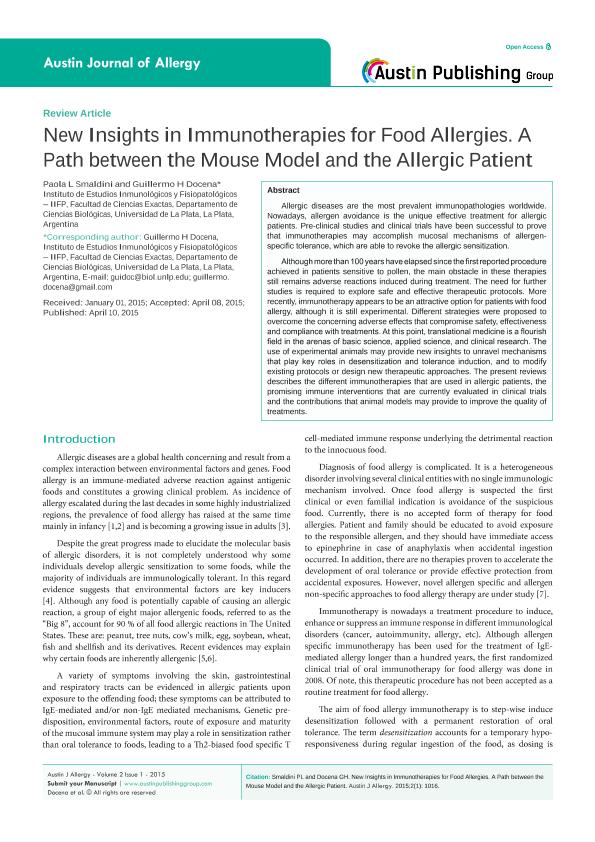Mostrar el registro sencillo del ítem
dc.contributor.author
Smaldini, Paola Lorena

dc.contributor.author
Docena, Guillermo H.

dc.date.available
2018-08-07T17:53:32Z
dc.date.issued
2015-04
dc.identifier.citation
Smaldini, Paola Lorena; Docena, Guillermo H.; New Insights in Immunotherapies for Food Allergies. A Path between the Mouse Model and the Allergic Patient; Austin Publishing Group; Austin Journal of Allergy; 2; 4-2015; 1-6
dc.identifier.issn
2378-6655
dc.identifier.uri
http://hdl.handle.net/11336/54449
dc.description.abstract
Allergic diseases are the most prevalent immunopathologies worldwide.Nowadays, allergen avoidance is the unique effective treatment for allergic patients. Pre-clinical studies and clinical trials have been successful to provethat immunotherapies may accomplish mucosal mechanisms of allergenspecifictolerance, which are able to revoke the allergic sensitization. Although more than 100 years have elapsed since the first reported procedure achieved in patients sensitive to pollen, the main obstacle in these therapies still remains adverse reactions induced during treatment. The need for further studies is required to explore safe and effective therapeutic protocols. More recently, immunotherapy appears to be an attractive option for patients with food allergy, although it is still experimental. Different strategies were proposed to overcome the concerning adverse effects that compromise safety, effectiveness and compliance with treatments. At this point, translational medicine is a flourish field in the arenas of basic science, applied science, and clinical research. The use of experimental animals may provide new insights to unravel mechanisms that play key roles in desensitization and tolerance induction, and to modify existing protocols or design new therapeutic approaches. The present reviews describes the different immunotherapies that are used in allergic patients, the promising immune interventions that are currently evaluated in clinical trials and the contributions that animal models may provide to improve the quality of treatments.
dc.format
application/pdf
dc.language.iso
eng
dc.publisher
Austin Publishing Group
dc.rights
info:eu-repo/semantics/openAccess
dc.rights.uri
https://creativecommons.org/licenses/by-nc-sa/2.5/ar/
dc.subject
Food-Allergy
dc.subject
Mouse-Model
dc.subject
Immunotherapy
dc.subject.classification
Inmunología

dc.subject.classification
Medicina Básica

dc.subject.classification
CIENCIAS MÉDICAS Y DE LA SALUD

dc.title
New Insights in Immunotherapies for Food Allergies. A Path between the Mouse Model and the Allergic Patient
dc.type
info:eu-repo/semantics/article
dc.type
info:ar-repo/semantics/artículo
dc.type
info:eu-repo/semantics/publishedVersion
dc.date.updated
2018-08-02T15:30:49Z
dc.journal.volume
2
dc.journal.pagination
1-6
dc.journal.pais
Estados Unidos

dc.journal.ciudad
Nueva Jersey
dc.description.fil
Fil: Smaldini, Paola Lorena. Consejo Nacional de Investigaciones Científicas y Técnicas. Centro Científico Tecnológico Conicet - La Plata. Instituto de Estudios Inmunológicos y Fisiopatológicos. Universidad Nacional de La Plata. Facultad de Ciencias Exactas. Instituto de Estudios Inmunológicos y Fisiopatológicos; Argentina
dc.description.fil
Fil: Docena, Guillermo H.. Consejo Nacional de Investigaciones Científicas y Técnicas. Centro Científico Tecnológico Conicet - La Plata. Instituto de Estudios Inmunológicos y Fisiopatológicos. Universidad Nacional de La Plata. Facultad de Ciencias Exactas. Instituto de Estudios Inmunológicos y Fisiopatológicos; Argentina
dc.journal.title
Austin Journal of Allergy
dc.relation.alternativeid
info:eu-repo/semantics/altIdentifier/url/http://austinpublishinggroup.com/allergy/fulltext/aja-v2-id1016.php
Archivos asociados
